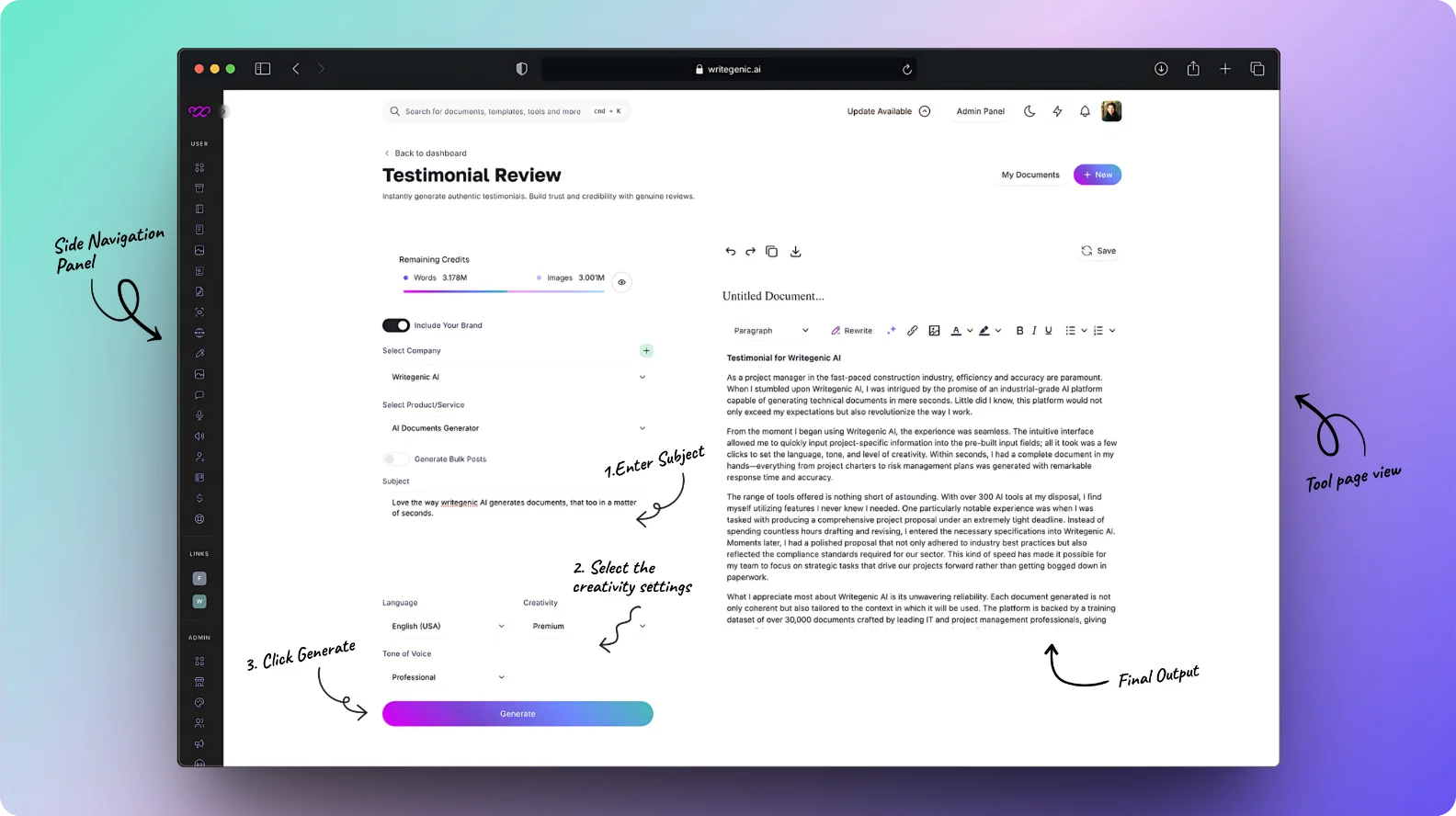Writing Testimonials That Work: Step-by-Step Guide

Writing Testimonials that are truly appealing to your readership is essential for establishing credibility and trust. In the current digital world, before people make a purchase, they frequently turn to the experience of other people.
Testimonial writing has a great influence on the brand, where more conversions and customer loyalty can be achieved because of the well-written testimonials. Using this step-by-step guide, you will be in a position of knowing all that you need to know to offer great testimonials that will sway potential customers, as well as raise your business.
According to statistics, close to 92 percent of the consumers read online reviews and testaments before they make their purchasing decisions. Further, 72 percent of clients claim that a product praise makes them more confident in a company.
Such statistics point at the worth of a good writing testimonial that delivers. Engaging in a proper organization of your presentation of food experiences to the customers, it is possible to draw attention to the strong side of the product or service you are offering and to draw a very effective conversation with the readers.
Table of Contents
Understanding Testimonials
What Makes Testimonials Important?
Testimonials play an important part in marketing as it offers social evidence about the worth of your brand. They demonstrate how your products or services can be used to solve the actual problems of real people. And when you learn about the nature of testimonials, you will be able to exploit the power of this instrument to promote your business efficiently.
- Builds Trust: A well-crafted testimonial can instill trust in your brand.
- Creates Connection: Testimonials help potential customers see themselves in the experiences shared.
- Increases Conversions: The right testimonial can turn a hesitant visitor into a buyer.
Types of Testimonials
Some of the types of testimonials that you can use are written testimonials, video testimonials and case studies. Both forms are unique in their own right and can satisfy audiences of various preferences.
- Written Testimonials: Easy to display on websites and promotional materials.
- Video Testimonials: Offer authenticity and human connection.
- Case Studies: Provide in-depth insights into how your product or service delivered success.
Crafting the Structure of an Effective Testimonial
Key Elements to Include
Any successful testimonial will have the purpose of telling a story. A good testimonial should have details about a problem, solution and result. This story structure is interesting and makes a reader continue reading the story.
- Problem Statement: Describe the challenge the customer faced before using your product.
- Solution Provided: Explain how your product or service addressed that challenge.
- Outcome: Highlight the positive changes that occurred as a result of using your product.
Organizing Your Testimonial
Use a good opening to impress. Continue with corroborating information with the voice and point of view of the client brought to the fore.
- Opening Line: Start with a bold statement or emotion.
- Supporting Details: Use facts and figures where applicable.
- Conclusion: Reinforce the positive outcome with a strong closing line.
Writing a Testimonial Script
Best Practices for Writing Scripts
When working on a script to your testimonials, listen to the voice of your customer and strive to be real. Speak words that your recipients will hear in their lives.
- Be Authentic: Use the client’s own words and avoid overly promotional language.
- Stay Concise: Keep it brief to maintain attention.
- Focus on Emotions: Highlight feelings associated with the product or service.
Script Layout
Writing testimonials can be greatly improved with a proper structure. Using bullet points or dividing content into short paragraphs helps highlight key points, making the information easier to digest for potential customers.
- Introduction: Who is the customer and what is their background?
- Challenges Faced: What did they struggle with?
- Solution and Outcome: What happened after using your product?
Writing Testimonials Made Easy with Writegenic AI
We have made it easy to develop high converting testimonials by eliminating the guess work. WriteGenic AI, based on thought-through marketing approaches, can create individual, natural, and professional testimonials within minutes.
There is nothing much to do but enter the subject line. Select your tone or industry style and watch what happens. Click generate and you will receive ready-to-use content for writing testimonials that increase your credibility and drive conversions. It is quick, precise, and effortless—like having an on-time copywriter at your disposal.

Gathering Authentic Testimonials
How to Gather Testimonials Effectively
Gathering testimonials should not be difficult. Ask your satisfied customers to share their opinion in different ways: Survey, email, or a social network.
- Personal Outreach: Directly reach out to happy customers.
- Incentivize Feedback: Consider offering discounts or rewards for testimonials.
- Utilize Automated Surveys: Use tools to streamline the feedback process.
Creating a Positive Experience
Ensure that customers do not struggle with giving feedback. Provide some rules and easy, convenient procedures that will motivate deeper answers.
- Clear Instructions: Guide them on what to write.
- Short and Friendly Surveys: Respect their time while gathering meaningful insights.
- Follow-up Appreciation: Thank them for their contribution; show you value their input.
Polishing and Formatting Testimonials
Final Touches That Matter
After collecting testimonials, the second step would be to refine these pieces. It is critical to make them presentable and appealing.
- Consistent Formatting: Use a standard font and style for all testimonials.
- Images and Headshots: Including an image of the customer can enhance credibility.
- Highlight Key Quotes: Pulling out key phrases makes standout points easy to identify.
Edit for Clarity
You need to retain the voice of your customers; however, some few edits to make it readable in terms of clarity and grammatical structure can only make it even more readable without interfering with the authenticity.
- Shorten Lengths: Eliminate unnecessary words or phrases.
- Clarify Details: Ensure all names and numbers are accurate.
- Avoid Jargon: Keep it relatable to your audience.
Placement and Multi-Channel Use
Where to Place Testimonials
The placement of testimonials is extremely important. It is visible at high-traffic sites of your own site and also on multi channels sites.
- Homepage: First impressions are crucial; include key testimonials on your homepage.
- Landing Pages: Use testimonials that align with specific offers.
- Social Media: Share testimonials through posts and stories for wider reach.
Multi-Channel Uses
Make use of testimonials wherever possible to boost your branding and message. This may involve both print materials or mailing via emails and this will improve the range of your influence.
- Email Campaigns: Embed customer testimonials in your newsletters.
- Social Proof on Ads: Use snippets for advertising campaigns.
- Sales Presentations: Integrate testimonials into your sales decks.
Measuring the Effectiveness of Testimonials
Key Metrics to Track
In order to determine the actual efficiency of your testimonials, monitor some of the metrics that would show how they are helping your business.
- Conversion Rates: Monitor the percentage of visitors who become customers.
- Engagement Metrics: Track social media likes, shares, and comments on testimonial content.
- Customer Feedback: Collect and analyze further responses to the testimonials displayed.
Tools and Techniques
Analytics can be used to determine the power of testimonies in influencing customer behavior. This may be A/B testing or visitor tracking paths in your site.
- Google Analytics: Monitor where traffic comes from and how it behaves.
- Heat Maps: Analyze visitor engagement with testimonials.
- Customer Surveys: Collect feedback on testimonial effectiveness directly from customers.
Legal and Ethical Considerations
Understanding Risks
Although testimonials are capable of enhancing your marketing, inability to follow the legal directives may cause problems. Such risks need to be identified in order to prevent future problems.
- Accuracy: Ensure testimonials accurately reflect customer experiences.
- Consent: Always seek permission before using a testimonial publicly.
- Disclosure: Be transparent about whether customers received compensation.
Best Practices
Best practices will ensure that your business is secured and generates trust in your audience.
- Document Consent: Keep records of testimonials and permission granted.
- Clarify Authenticity: Clearly label any sponsored testimonials.
- Adhere to Industry Standards: Follow specific guidelines set by advertising authorities.
Avoiding Common Pitfalls in Writing Testimonials
Mistakes to Watch For
There are certain difficulties and challenges in writing testimonials. It is also possible to learn to recognize and to avoid typical pitfalls so that your testimonials can work much better.
- Overly Promotional Language: This can alienate readers; focus on genuine experiences.
- Generic Statements: Testimonials should be specific and relatable.
- Neglecting to Update: Regularly refresh testimonials to maintain relevance.
Strategies to Improve
Use strategies that would limit such issues and make your testimonials be of good quality.
- Regular Reviews: Assess testimonials periodically for continued relevance.
- Diverse Testimonials: Seek varied customer experiences to provide a broader narrative.
- Feedback Loops: Create a process for customers to suggest improvements on their testimonials.
Real-World Examples of Writing Testimonials
Effective Case Studies
When considering good examples of testimonials in practice, it is possible to derive information on what is the most effective. Some brands have perfected this technique and consequently have been able to hike on trust with genuine testimonials.
- Brand X: Implemented customer testimonials at the checkout stage—boosting conversions by 30%.
- Brand Y: Featured video testimonials prominently on social media, increasing engagement rates significantly.
Learning from Others
When dealing with customer testimonials, researching on successful brands can act as a motivation on your strategies.
- Social Proof: Customers aren’t just looking for a product; they’re looking for reassurance and trust.
- Continuous Improvement: Monitor competitors and observe trends to evolve your testimonial strategies.
Final Thoughts
The art and strategy of writing testimonials that work is a careful endeavor. Knowing what makes a testimonial effective, crafting it in a coherent way and effectively gauging its effectiveness, you will be in a good position to use the power of customer voices. However, never forget to choose authenticity and clarity, as your customers will value the real things that would strike a chord with them.
When going through the channels of collecting and portraying testimonials, always maintain dialogue with your audience. Feedback works both ways; obtain it as a way of perfecting your approach. There is no doubt that by doing so, you not only focus on writing testimonials but also develop effective stories capable of improving your brand identity and building customer confidence.
FAQs About Writing Testimonials
What makes a good testimonial?
When writing testimonials, they should be real, realistic, and include clear details of what the customer experienced.
How do I ask for testimonials?
When focused on writing testimonials, contact customers on a personal level, make submission convenient, and offer a bonus where possible.
Can I edit customer testimonials?
While writing testimonials, you can sharpen them to sound clear, but always retain the original tone of the customer.
What if I don’t have enough testimonials?
If you’re working on writing testimonials, be proactive with customers, conduct feedback campaigns, or reward reviews.
Are video testimonials effective?
Yes, when writing testimonials, consider video testimonials as they are often more persuasive and personalized.

